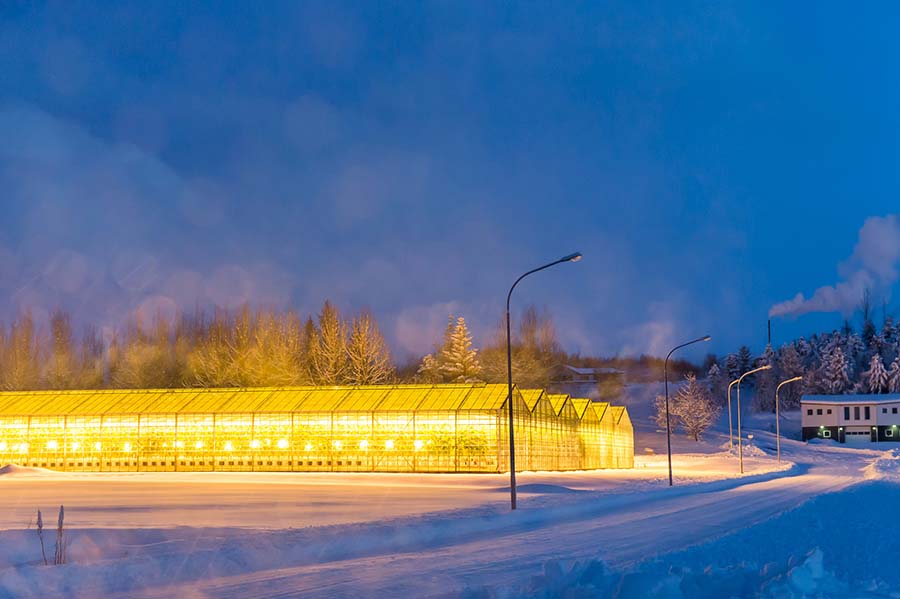For anyone living in a region with a short growing season, the dream of harvesting fresh, affordable homegrown food year-round is probably dismissed as an expensive fantasy. While traditional greenhouses have successfully extended growing seasons in temperate climates across the globe, they tend to come with high energy bills and a significant environmental cost, particularly in challenging climates. Fortunately, by tapping into Earth’s stable, virtually limitless energy, today’s geothermal greenhouses offer a compelling solution to both problems. This guide will cover the core science, design choices, and economic realities of geothermal greenhouse technology, so you can produce affordable, sustainable, homegrown produce wherever you live.
Why Geothermal? The Problem with Traditional Greenhouses
While conventional greenhouses have proven remarkably successful at extending growing seasons, doing so in a cold climate comes at a steep price. The primary challenge is maintaining a growing space that can be kept in a temperature range where vegetables and fruiting plants reliably produce. This requires an immense amount of energy for heating, which creates both a financial burden and a significant environmental impact. In fact, typical heating systems powered by fossil fuels can account for a staggering 50 to 80 percent of a greenhouse’s total operating costs. Such heavy energy use means a single greenhouse-grown tomato can be responsible for six times the carbon emissions of a field-grown one, even after accounting for long-distance transportation.
This is a constant challenge for growers in cold-climate communities, from high-altitude mountain towns to extreme northern latitudes like Alaska and Iceland. In regions like these that feature harsh winters and short growing seasons, the high cost (both financial and environmental) of conventional greenhouse heating is a significant financial barrier and effectively limits the availability of fresh, locally grown food precisely when it is needed most.
The Geothermal Advantage
Geothermal systems solve the single biggest challenge of four-season growing in a cold climate: the massive cost and carbon footprint of heating. Instead of burning fossil fuels, a geothermal greenhouse taps into the stable, consistent temperature of the ground to maintain the perfect growing environment year-round. This approach dramatically cuts operating costs, provides greater food security, and builds a genuinely sustainable agricultural model.
Better for the Budget and the Environment
By replacing conventional heaters, a geothermal system can virtually eliminate a greenhouse’s heating-related CO2 emissions. In geothermal hotspots like Iceland, this advantage is compounded. Large-scale power plants use geothermal energy to generate clean electricity, so that even supplemental lighting and equipment can run on renewable energy for a truly sustainable operation. To conserve resources even further, the water used in many direct-use heating systems can be continually recycled.
Freedom from the Seasons
The most powerful promise of a geothermal greenhouse is the ability to defy the calendar, producing fresh food year-round regardless of the weather outside. This technology unlocks the potential for local agriculture in regions with even the most extreme winters and shortest growing seasons.
Perhaps nowhere is this promise more dramatically on display than at Chena Hot Springs in Alaska. Here, deep in the interior where winter temperatures can plummet to -40°F (and lower!) and winter daylight is scarce, a series of geothermal greenhouses produce thousands of pounds of fresh lettuce, tomatoes, peppers, and herbs year-round. By using the 165°F water from the local hot springs, they maintain a perfect growing environment, supplying their resort and the nearby Fairbanks community with produce that would otherwise have to be shipped thousands of miles.
While this is an extreme example, the principle applies everywhere. From large commercial vegetable growers in the Rocky Mountains to small community projects, geothermal heat is making year-round local agriculture a reality in climates once considered impossible for off-season farming.
Building a Resilient Community
The advantages of geothermal power aren’t limited to a single greenhouse operation. In fact, geothermal agriculture has proven to be a powerful tool for building local food security and creating sustainable, community-wide food systems.
Greenhouses provide a reliable source of freshly harvested produce year-round, allowing growers to tackle issues like food insecurity head-on by directly supplying community cornerstones like food pantries, schools, and senior centers. For small farmers, community groups, and tribal nations, sustainable geothermal technology provides a critical opportunity to increase yields, diversify crops, and build a self-sufficient local food supply even in the harshest climates.
Pagosa Springs, Colorado
Surrounded by rugged mountains and a vast national forest, the town of Pagosa Springs, Colorado, balances small-town vibes, a lively tourist trade, and a wealth of vibrant cultural opportunities. It also faces unique challenges arising from its harsh winters and short growing season. This makes local agriculture difficult and expensive, a serious issue for a community where more than one in ten residents lacks reliable access to food. However, the town sits on a powerful resource: the world’s deepest geothermal hot spring, plunging to a depth of at least 1,002 feet.
A nonprofit called the Geothermal Greenhouse Partnership (GGP) was formed to leverage this unique asset for the benefit of the community. The GGP built three geodesic domed greenhouses that are heated using an indirect, closed-loop system. Hot geothermal water from a town well is used to warm conventional water in a separate set of pipes running beneath the greenhouse pathways. This design essentially turns the floors into giant radiators.
The result is a year-round growing environment that defies the single-digit winter temperatures outside. The greenhouse domes produce a fascinating variety of fresh foods, from herb beds of basil and rosemary to mature fig trees. This produce directly supports the community by supplying local food pantries, senior centers, and schools. The project now serves as a working model for how geothermal energy can support a resilient and secure local food system.
Looking Ahead
With the challenge and the incredible opportunity now clear, the next logical question is 'how?' How is the stable heat of the earth actually harnessed? The next chapter breaks down the science of the two core geothermal technologies.




